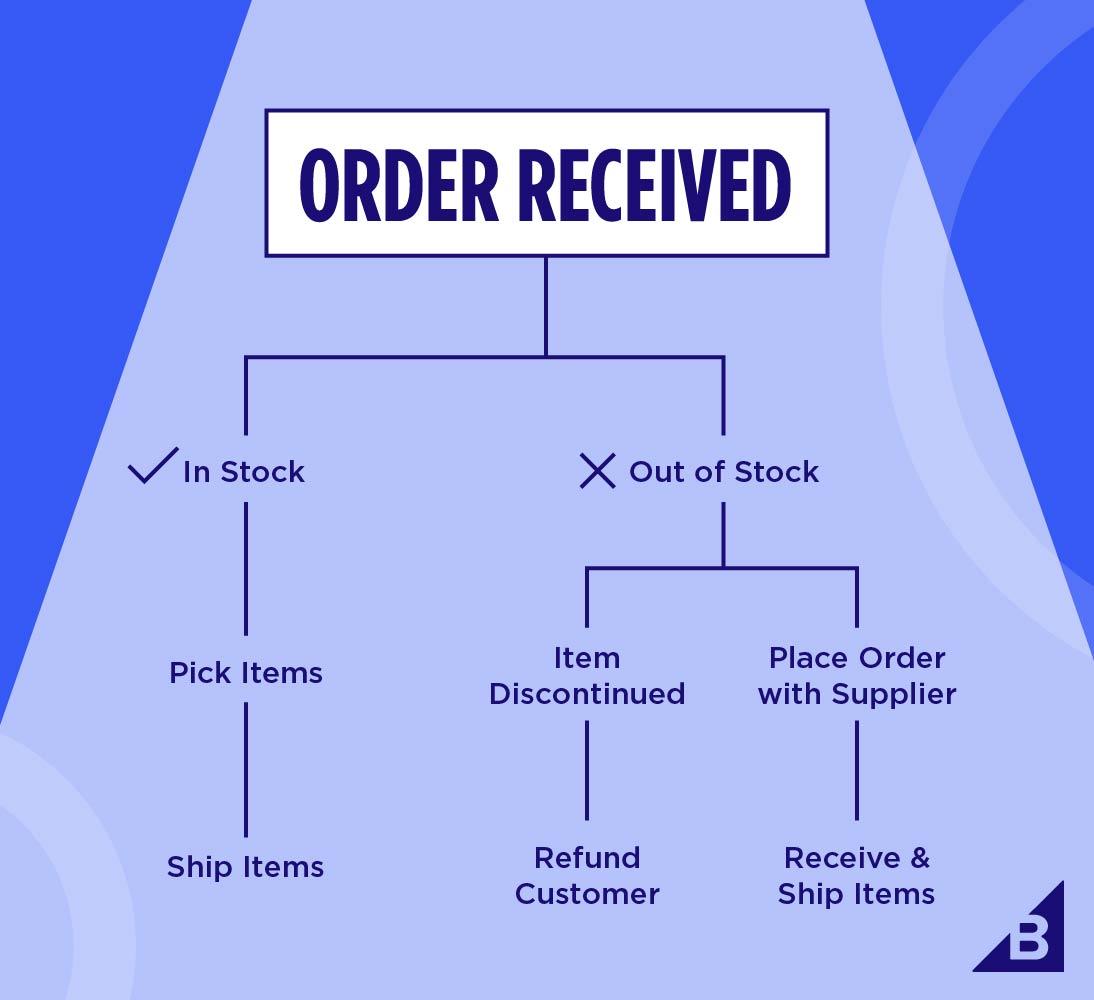- Enterprise
- Essentials
Inventory Management Techniques Every Online Business Needs to Know

Increase Your Ecommerce Sales from $1 million to $100 Million
Picture your favorite retailer.
Whether it’s a local boutique or a large enterprise, ask yourself a couple questions:
- Do they consistently have the products in stock that you want?
- Do they carry goods both in-store and online?
If the answers are yes, chances are they probably have a good handle on their inventory management.
What is Inventory Management?
Inventory management — a crucial component of supply chain management — is the process of tracking stock levels and the movement of goods, whether it be delivering raw materials to manufacturers or fulfilling orders for finished products.
Inventory management is the fundamental building block to longevity, helping businesses to minimize costs, improve cash flow and boost profitability.
When your inventory is properly organized, the rest of your supply chain will fall into place. Without it, you risk a litany of mistakes like mis-shipments, shortages, out-of-stocks, spoilage (when dealing with perishable stock items), overstocks, mis-picks and so on.
Nonetheless, 43% of small businesses still don’t track their inventory, and, on average, U.S. retail operations have a supply chain accuracy of only 63% — which means many retailers aren’t taking advantage of the inventory management software available.
Unlike an enterprise resource planning (ERP) system, an inventory management system focuses on one supply chain process. They often come with the ability to integrate with other software systems — POS (point of sale), sales channel management, shipping — so you can build a personalized integration stack to meet the unique needs of your business.
Process of Inventory Management
Before building an inventory management plan, you’ll need to have a solid understanding of each step in the inventory management process. This is crucial to minimizing error and choosing the most effective inventory management software for your business.
- Goods are delivered to your facility. This is when raw materials and subcomponents for manufacturers or finished goods for consumers first enter your warehouse.
- Inspect, sort and store goods. Whether you use dropshipping, cross-docking or a different warehouse management system, this when inventory is reviewed, sorted and stored in their respective stock areas.
- Monitor inventory levels. This may be through physical inventory counts, perpetual inventory software or cycle counts and helps minimize the chance of error.
- Stock orders are placed. Customers place orders either on your website or in-store.
- Stock orders are approved. This is when you pass the order to your supplier, or it may be automated through your POS system.
- Take goods from stock. The necessary goods are found by SKU number, taken from stock and shipped to the manufacturer or customer.
- Update inventory levels. Using a perpetual inventory system, you can automatically update inventory levels and share with necessary stakeholders.
- Low stock levels trigger purchasing/reordering. Restock inventory as needed.
To better visualize these eight steps, try creating an inventory process map like the one below. Track and review each step of the process in order to minimize out-of-stock and overstocked inventory.

Inventory Management Techniques
Especially for larger apps with lots of moving parts, inventory management can become complex, encompassing several techniques and strategies. Let’s take a look at some inventory control techniques you may choose to utilize in your own warehouse.
Economic order quantity.
Economic order quantity (EOQ) is a formula for how much inventory a company should purchase with a set of variables like total costs of production, demand rate and other factors. The formula identifies the greatest number of units in order to minimize buying, holding and other costs.
Minimum order quantity.
Minimum order quantity (MOQ) is the smallest amount of inventory a retail business will purchase in order to keep costs low. However, keep in mind that inventory items that cost more to produce typically have a smaller MOQ, as opposed to cheaper items that are easier and more cost effective to make.
ABC analysis.
This technique splits goods into three categories to identify items that have a heavy impact on overall inventory cost.
- Category A is your most valuable products that contribute the most to overall profit.
- Category B is the products that fall in between the most and least valuable.
- Category C is for small transactions that are vital for overall profit but don’t matter much individually.
Just-in-time inventory management.
Just-in-time (JIT) inventory management is a technique in which companies receive inventory on an as-needed basis instead of ordering too much and risking dead stock (inventory that was never sold or used by customers before being removed from sale status).
Safety stock inventory.
Safety stock inventory management is extra inventory that is ordered and set aside in case the company doesn’t have enough for replenishment. This helps prevent stock-outs typically caused by incorrect forecasting or unforeseen changes in customer demand.
FIFO and LIFO.
LIFO and FIFO are methods to determine the cost of goods. FIFO, or first-in, first-out, assumes the older inventory is sold first in order to keep inventory fresh.
LIFO, or last-in, first-out, assumes the newer inventory is typically sold first to prevent inventory from going bad.
Reorder point formula.
The reorder point formula calculates the minimum amount of stock a business should have before reordering. A reorder point is usually higher than a safety stock number to factor in lead time.
Batch tracking.
Batch tracking is a quality control technique wherein users can group and monitor similar goods to track inventory expiration or trace defective items back to their original batch.
Consignment inventory.
If you’re thinking about your local consignment store here, you’re exactly right.
Consignment inventory is when a consigner (vendor or wholesaler) agrees to give a consignee (retailer) their goods without the consignee paying for the inventory upfront. The consigner offering the inventory still owns the goods, and the consignee pays for them only when they sell.
Perpetual inventory management.
Perpetual inventory management is simply counting inventory as soon as it arrives to deliver real-time insights.
It’s the most basic type of inventory management system and can be recorded manually on pen and paper or an Excel spreadsheet. Or, by using handheld devices that scan product barcodes and RFID tags, you may use an inventory system that automates inventory balances as soon as stock is moved, sold, used or discarded.
Dropshipping.
Dropshipping is an order fulfillment method in which the supplier ships products directly to the customer. When a store makes a sale, instead of picking the item from their own inventory, they purchase the item from a third party and have it shipped to the consumer.
Lean Manufacturing.
Lean manufacturing is a broad set of management practices that can be applied to any business practice. Its goal is to improve efficiency by eliminating waste and any non-value-adding activities from daily business.
Six Sigma.
Six Sigma is a method that gives companies tools to improve the performance of their business (increase profits) and decrease excess inventory.
Lean Six Sigma.
Lean Six Sigma enhances the tools of Six Sigma, but instead focuses more on increasing word standardization and the flow of business.
Demand forecasting.
Demand forecasting is based on historical sales data to forecast customer demand. Essentially, it’s an estimate of the goods and services a company expects customers to purchase in the future.
Cross-docking.
Cross-docking is a technique whereby a supplier truck unloads materials directly into outbound trucks to create a JIT shipping process. This essentially eliminates warehousing, and there is little to no storage in between deliveries.
Bulk shipments.
Bulk shipments is a cost efficient method of shipping in which a business palletizes inventory to ship more at once. To see some examples of effective inventory management in action, check out our BigCommerce Case Studies page, where you can find success stories from both B2C and B2B merchants.
The Final Word
Whether you’re a brick-and-mortar, ecommerce or multichannel retailer, inventory management is crucial if you want to seriously compete and give your customers the experience they want. Without implementing inventory management techniques, you’ll never get ahead.
Sign up with an inventory software that masters the basics of inventory management and acts as a catalyst for your growth, or choose an ecommerce platform like BigCommerce that allows you to centralize your store’s inventory management across all channels.
FAQs About Inventory Management
Especially with a topic as broad and complex as inventory management, there’s bound to be a slew of questions. Here are our answers to a few of them:
How do you reduce inventory costs?
A growing business likely means increasing demand and higher overhead costs. Inventory can be costly, especially when you account for warehousing, damaged items and replacements, spoilage and quality control.
Here are some of the best ways to free up capital and minimize inventory management costs:
- Avoid overstocking: Instead, invest in trying out new products and looking for new opportunities to grow your business.
- Get rid of your deadstock: Return obsolete inventory to the supplier, bundle it together and sell it at a discounted price or donate it to free up space in your warehouse.
- Reduce supplier lead time. By reducing the amount of time between shipments, you’ll be able to reduce how much stock you have on hand.
- Choose better inventory management software: This can help centralize control of your inventory and automate processes.
How do you measure to see if you are successfully managing inventory?
The proof is in the numbers when measuring the success rate of inventory management.
After you have implemented new inventory management techniques, compare data and KPIs from before and after. Some seasonality and inventory metrics include stockouts, mis-stocks, inventory turnover ratio, dead stock and order cycle time.
Have your level of mis-shipments, mis-picks or out-of-stocks decreased? What about dead stock? Have you eliminated the dead piles of inventory around the perimeter of the warehouse?
If you can answer yes to these, you’ve successfully conducted inventory management. As a result, you may expect to see better customer reviews, improved customer loyalty and even a boost in Amazon Seller Rating Performance.
What is the difference between inventory management and order management?
Order management is the process of tracking customer orders, whereas inventory management is the process of tracking stock levels and the movement of goods, whether it be delivering raw materials to manufacturers or fulfilling orders for finished products.
Thus, inventory management is an important aspect of order management, since order fulfillment requires the right amount of inventory to be available. Luckily, inventory management systems can work to integrate the two, making it easier for business owners to keep products in stock and fulfill orders in a timely manner.
What do inventory management systems do?
The goal of inventory management systems is to know where your inventory is at any given time and how much of it you have in order to manage inventory levels correctly.
They streamline and optimize inventory levels and maintain product availability across all sales channels, giving you a centralized view of your inventory and purchase orders. With the help of inventory management software, ecommerce businesses can free up and reallocate capital, minimize inventory costs and enhance customer satisfaction.
How to pick the best inventory management system?
Ultimately, there is no one-size-fits-all inventory management system.
The key to choosing the best inventory management solution is to identify what features and functionality your business needs.
Do you need to track inventory trends? Are you looking for multi-location inventory management? Do you need to automate workflows and accounting?
Make a list of your business priorities and use it to narrow down your options.
Does BigCommerce integrate with inventory management software?
Yes! Click here to browse popular inventory management solutions we currently integrate with. If you don’t see an ecommerce platform or have your own custom solution, get in touch with our team to discuss your options.



